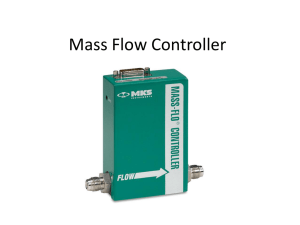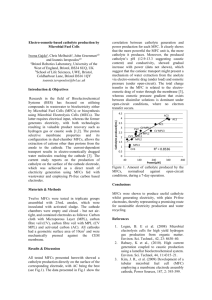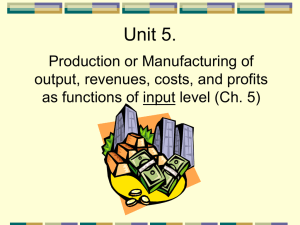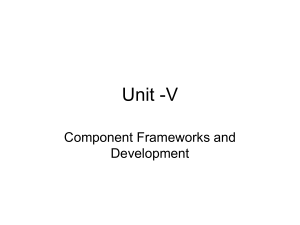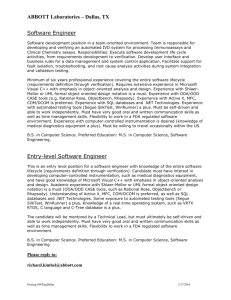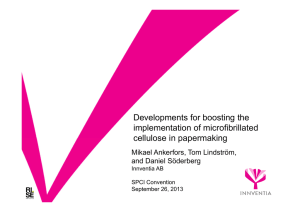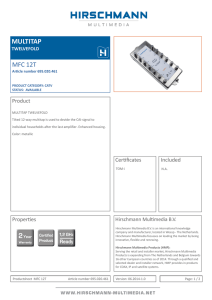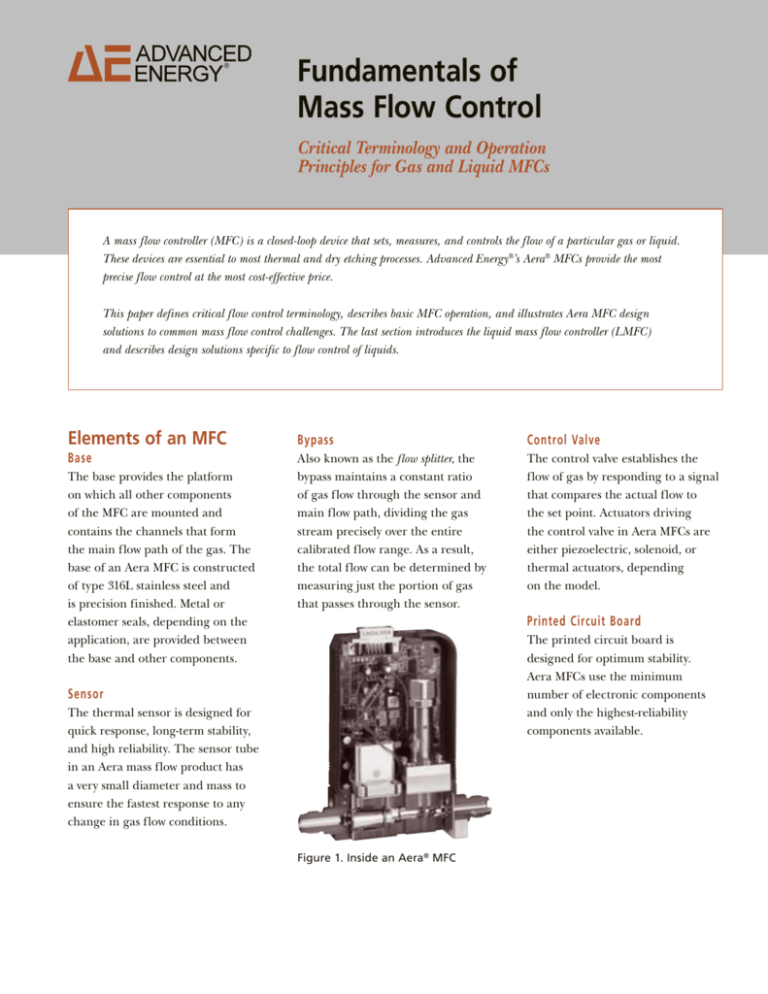
Fundamentals of
Mass Flow Control
Critical Terminology and Operation
Principles for Gas and Liquid MFCs
A mass flow controller (MFC) is a closed-loop device that sets, measures, and controls the flow of a particular gas or liquid.
These devices are essential to most thermal and dry etching processes. Advanced Energy®’s Aera® MFCs provide the most
precise flow control at the most cost-effective price.
This paper defines critical flow control terminology, describes basic MFC operation, and illustrates Aera MFC design
solutions to common mass flow control challenges. The last section introduces the liquid mass flow controller (LMFC)
and describes design solutions specific to flow control of liquids.
Elements of an MFC
Bypass
Control Valve
Base
Also known as the flow splitter, the
bypass maintains a constant ratio
of gas flow through the sensor and
main flow path, dividing the gas
stream precisely over the entire
calibrated flow range. As a result,
the total flow can be determined by
measuring just the portion of gas
that passes through the sensor.
The control valve establishes the
flow of gas by responding to a signal
that compares the actual flow to
the set point. Actuators driving
the control valve in Aera MFCs are
either piezoelectric, solenoid, or
thermal actuators, depending
on the model.
The base provides the platform
on which all other components
of the MFC are mounted and
contains the channels that form
the main flow path of the gas. The
base of an Aera MFC is constructed
of type 316L stainless steel and
is precision finished. Metal or
elastomer seals, depending on the
application, are provided between
the base and other components.
Printed Circuit Board
The printed circuit board is
designed for optimum stability.
Aera MFCs use the minimum
number of electronic components
and only the highest-reliability
components available.
Sensor
The thermal sensor is designed for
quick response, long-term stability,
and high reliability. The sensor tube
in an Aera mass flow product has
a very small diameter and mass to
ensure the fastest response to any
change in gas flow conditions.
Figure 1. Inside an Aera® MFC
advanc e d
e n e r g y
Operating Principle
The heart of a mass flow controller
is a thermal sensor. It consists
of a small bore tube with two
resistance-thermometer elements
wound around the outside of the
tube. The sensor tube is heated by
applying an electric current to the
elements. A constant proportion of
gas flows through the sensor tube,
and the cooling effect creates a
temperature differential between
the two elements. The change in the
resistance due to the temperature
differential is measured as an
electrical signal.
The temperature differential created
between the elements is dependent
on the mass flow of the gas and is a
function of its density, specific heat,
and flow rate. Mass flow is normally
displayed in terms of volume of
the gas either in standard cubic
centimeters per minute (sccm) or
in standard liters per minute (slm).
The electronics of a mass flow
controller convert mass flow into
volume flow at standard conditions
of 0°C (32°F) and 1 atmosphere.
Because the volume of 1 mole of
an ideal gas at 0° C (32°F) and 1
atmosphere occupies 22.4 liters, a set
point of 22.4 slm will cause 1 mole
of gas to flow during 1 minute.
The bypass forces a constant
proportion of the incoming gas to
be fed into the sensor. The gas flow
through the sensor tube causes
heat to be transferred from the
upstream resistance-thermometer
element to the downstream
resistance-thermometer element.
This temperature differential is
linearized and amplified into a 0 to
5 V flow output signal by means of a
bridge circuit. The output signal is
compared with the external set point
signal to the mass flow controller.
The error signal that results from
comparing the output signal with
the set point signal directs the
control valve to open or close to
maintain a constant flow at the
set point level.
Gas Flow
Figure 3. Sensor temperature profile
Performance
and Reliability
MFC manufacturers go to great
lengths to explain why their
products should outperform others,
often focusing on a few design
features. But it is not enough
to define MFC performance
on the basis of a few parameters—
today’s critical processes demand
MFCs that deliver outstanding
performance and reliability.
The primary factors include:
Accuracy
Figure 2. Operational diagram
2
No Flow
Condition
Accuracy refers to the difference
between the actual flow of an MFC
and that of a primary standard at
any set point.
w h i t e
Repeatability
Pressure Change Response
Another primary factor is the
repeatability of actual flow for an
MFC or from one MFC to another
at any set point.
Pressure change response is the
time that it takes for actual flow
to stabilize after a sudden change
in gas input pressure.
Linearity
Linearity is the straightness of the
curve of actual flow vs. set point, in
other words, accuracy over the entire
flow range.
Calibration Drift
Calibration drift is the change
in the curve of actual flow vs. set
point due to aging effects of some
of the component parts that make
up an MFC.
It is not enough to define MFC
performance on the basis of a
few parameters—today’s critical
processes demand MFCs that
deliver outstanding performance
and reliability.
Temperature Change Effects
Stability
Stability refers to the ability of an
MFC to maintain stable flow levels
through short-term effects such as
pressure and temperature changes,
and through long-term effects such
as aging of the component parts.
Response or Settling Time
The time that it takes for actual flow
to stabilize after a set point change is
another critical parameter.
Over-shoot and Under-shoot
Over-shoot and under-shoot refer to
any spike or dip, respectively, in the
response curve of actual flow vs. time.
This parameter concerns the
stability of flow during ambient
temperature variations.
Zero Drift
Zero drift is the most common
complaint of MFC users. It is
a time-dependent shifting of the
zero calibration point from its
original zero value to an offset
value, and is generally caused by
aging effects of various electrical
components on the PC board as well
as by aging of the sensor windings.
The aging phenomenon that results
in zero drift not only causes a shift
in the zero calibration point but
also causes a shift of the entire
curve of control voltage vs. flow.
p aper
Some MFC manufacturers,
particularly those with zero drift
problems, offer an option of
automatic zeroing. Auto zero does
indeed correct the shift in the
zero calibration point, but it does
not correct the shift of the entire
calibration curve. Admittedly,
the shift in the remainder of the
calibration curve is less severe than
that for the zero point, but it still
represents a degradation of accuracy
and linearity.
On the other hand, zero drift has
been essentially eliminated in Aera
flow products. The typical zero
drift of our MFCs is less than 0.5%
of full-scale flow over a period of
one year. This is the result of using
the highest-quality sensor wire and
electrical components on the PC
board. Perhaps more importantly,
the sensors and the assembled MFCs
are subjected to extensive burn-in
procedures and stringent, multiple
QC inspections to screen out all
marginal components and
assembled MFCs.
In this manner, we do not hide the
zero drift problem; we prevent it.
3
advanc e d
e n e r g y
Liquid Mass Flow
Controllers
Liquid sources have been used in
semiconductor processing for as long
as the industry has existed. In the
industry’s early days, liquids were
often chosen as source materials
because the proper techniques
for handling toxic and corrosive
gases were unfamiliar to many
development engineers. Gas leaks
were the norm, with frequent
harm to workers and equipment.
Today, handling procedures are
well understood, and leaks are
generally not a major problem.
Nevertheless, liquid sources are now
preferred over some gaseous sources
because of the appropriateness of
liquid reaction characteristics for
particular applications.
The most common method for
introducing liquid source materials
into reactors and furnace tubes
is to first vaporize the liquid and
then pass the vapors through mass
flow instruments that have been
developed specifically for controlling
vapor flow. Liquid sources can be
vaporized either by bubbling a
carrier gas through the liquid or by
heating the liquid to generate an
adequate vapor pressure. One major
constraint that is common to all
vaporization methods is that some
liquid sources have too low a vapor
pressure to generate adequate vapor
pressure at room temperature or
moderately elevated temperatures.
4
Instruments known as vaporizer
controllers are typically used to
control vapor flow generated using
the carrier gas technique. One type
of vaporizer controller combines an
MFC with a ratio detector consisting
of thermal conductivity cells that
measure the ratio of vapor to carrier
gas. The ratio detector provides
a signal to the MFC to adjust the
carrier gas flow to deliver a constant
amount of source vapor per unit
time, independent of all variables.
Another type of vaporizer controller
is a complex system that consists
of an MFC, a minicomputer, and
devices for measuring the major
variables: bubbler temperature and
pressure. All other variables are
assumed to be of minor importance.
The minicomputer calculates the
vapor pressure of the liquid source
based on the temperature and
pressure measurements and provides
a signal to the MFC to adjust the
carrier flow to deliver a constant
amount of source vapor per unit
time. The degree of saturation of
the carrier gas may vary depending
on bubbler design, liquid level, and
bubble size.
Calibration drift is common in
vaporizer controllers that use a
ratio detector, caused by cumulative
contamination of one of the thermal
conductivity cells as a result of
reaction between the source material
and finite concentrations of oxygen
or moisture in the carrier gas. There
are also accuracy and repeatability
limitations. For example, the
variable carrier gas flow rate
will at least slightly affect the
reproducibility of the mainstream
flow within a process chamber.
When vapor is generated by heating
a liquid source, MFCs are used to
control the flow of heated vapor. Recondensation is prevented by heating
the MFC and the lines leading to
and from it. For TEOS, a widely
used liquid source for mediumtemperature oxide deposition,
re-condensation is prevented by
confining a “high-temperature”
MFC and associated plumbing
within an isothermal enclosure
heated to near 80°C (176°F). This
configuration is sometimes known
as a thermal vaporizer system. To
withstand the elevated temperature,
the flow components and PC board
of the MFC are designed as separate
modules, with the flow component
module located in the enclosure
and the PC board module mounted
external to the enclosure.
A thermal vaporizer system is more
accurate and repeatable than the
carrier gas/bubbler technique, but
it requires a very large, expensive
system to enclose all of the
requisite hardware and maintain
an isothermal environment. Recondensation of the vapor can be a
chronic problem with this technique
unless stringent precautions are
taken to heat all lines leading from
the thermal vaporizer system to the
reactor or furnace tube.
A New Method for Flow Control
A mass flow control instrument
for metering very low flows of
liquid source materials into
process chambers is now available,
offering considerable advantages
over vaporizer techniques. This
instrument is a liquid mass flow
controller (LMFC) and is an
adaptation of basic mass flow control
technology. The LMFC provides
accuracy and repeatability, as well as
size and cost advantages.
An LMFC consists of the same flow
components found in traditional
MFCs. The major difference is that
each component must be designed to
prevent the most prevalent problem
with LMFCs—bubble formation
and retention. In an LMFC, a liquid
source can gain heat from the sensor
tube, which operates at an elevated
temperature, and from contact
with the internal parts of a control
valve if it is of a type that generates
heat. If bubbles were consequently
generated and retained, their
presence would adversely affect
accuracy and repeatability and
could cause malfunction of the
LMFC. The present design uses a
vertically configured flow path that
prevents retention of bubbles. The
inlet fitting is at a lower level than
the outlet fitting, and the sensor is
S-shaped rather than U-shaped as in
conventional MFCs. Additionally, the
control valve is of a piezoelectric/
diaphragm type, which has a much
cooler operating temperature
than other types of control valves
and permits no liquid to enter the
internal region of the valve. To
prevent bubble formation in the
heated sensor tube, the LMFC is
limited to liquids that have a boiling
point of at least 65°C (149°F).
Figure 4. Aera® LX-1200/1200C
series LMFC
Advanced Energy Industries, Inc. • 1625 Sharp Point Drive • Fort Collins, Colorado 80525
T: 800.446.9167 or 970.221.4670 • F: 970.221.5583 • support@aei.com • www.advanced-energy.com
United Kingdom
T: 44.1869.320022
F: 44.1869.325004
Germany
T: 49.711.779270
F: 49.711.7778700
Korea
T: 82.31.777.9191
F: 82.31.777.9195
Advanced Energy ®, AE®, and Aera® are trademarks of Advanced Energy Industries, Inc.
Japan
T: 81.3.32351511
F: 81.3.32353580
Taiwan
T: 886.2.82215599
F: 886.2.82215050
© Advanced Energy Industries, Inc. 2005
All rights reserved. Printed in U.S.A.
SL-MFCFUND-270-02 0M 6/05
China
T: 86.21.58579011
F: 86.21.58579003


